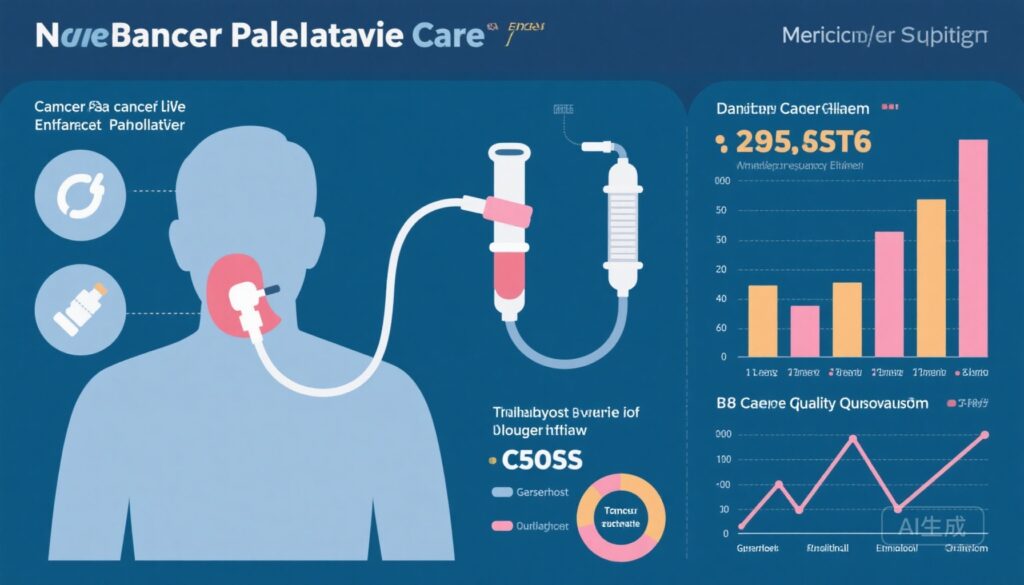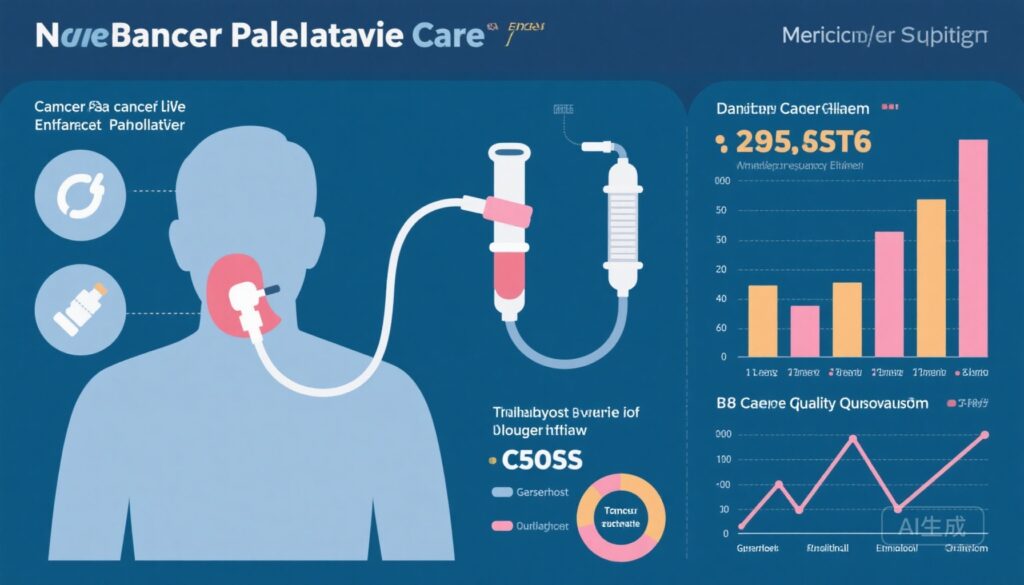Introduction
Head and neck cancer (HNC) presents unique clinical challenges as the disease often impairs vital functions such as breathing, swallowing, and speech. For many patients, interventions such as tracheostomy tubes (to aid breathing) or gastrostomy tubes (g-tubes, for feeding) become essential during later stages of illness. These medical devices, while life-prolonging, contribute to complex care needs and increased healthcare utilization, especially near the end of life. Simultaneously, palliative care (PC)—a specialized approach focused on quality of life and symptom management rather than curative treatment—is gaining recognition for its potential to improve patient comfort and reduce unnecessary interventions. Yet, how the timing of palliative care initiation interacts with the use of tracheostomy or gastrostomy tubes remains poorly understood, especially regarding costs and end-of-life outcomes for patients with HNC.
Understanding the Study: Objectives and Methods
A recent large population-based cohort study conducted in Ontario, Canada, analyzed over 11,000 patients diagnosed with HNC between 2007 and 2022 who had died by late 2023. Researchers linked administrative health data to assess whether the timing of palliative care—categorized as early (12 to 6 months before death), late (less than 6 months before death), or none—influenced health care costs and quality indicators among patients using tracheostomy or gastrostomy tubes.
Costs were measured as mean monthly healthcare expenditures during the last six months of life, adjusted to 2023 Canadian dollars. The study also examined rates of emergency department visits, hospital admissions without palliative care support, and the location of death (home versus hospital).
Key Results and What They Mean
Approximately 90% of patients received some form of palliative care. However, usage of tracheostomy and gastrostomy tubes during the last year of life was substantial—around 11.6% and 11.1%, respectively. Notably, the presence of these tubes was associated with significantly higher healthcare costs.
– Patients using a tracheostomy tube without receiving palliative care had nearly a threefold increase in costs compared to those without either intervention.
– Early initiation of palliative care attenuated, but did not eliminate, these cost increases.
– Late palliative care initiation was linked to the highest healthcare costs.
– Similar patterns were observed with gastrostomy tube use.
Interestingly, while many patients had emergency visits (81%) and hospital admissions (48.7%) in their final six months, those without palliative care were least likely to have these hospital encounters. Early palliative care was paradoxically associated with a lower likelihood of home deaths compared to no palliative care.
Clinical Implications: Balancing Cost, Quality, and Patient Preferences
This study highlights several important clinical considerations for managing patients with advanced HNC:
1. Resource Utilization and Costs: Tracheostomy and gastrostomy tubes significantly increase end-of-life healthcare costs, partly due to complex care needs and frequent hospital visits. Early engagement with palliative care teams may temper cost surges by improving symptom management and care coordination.
2. Hospital-based Care and Home Deaths: Contrary to common goals of palliative care—such as reducing aggressive hospital care and increasing home deaths—early palliative care did not translate into fewer hospital interventions or more deaths at home in this population. This suggests specialized management strategies are needed for HNC patients who face unique airway and nutritional challenges.
3. Importance of Team-Based Care: Patients with tracheostomy or gastrostomy tubes might benefit from early, multidisciplinary palliative teams including otorhinolaryngologists, oncologists, palliative care specialists, nutritionists, social workers, and nursing professionals to optimize quality of life and resource use.
A Patient’s Journey: Illustrative Case
Consider the case of James, a 70-year-old man diagnosed with advanced laryngeal cancer. As the tumor progressed, he required a tracheostomy to breathe and a gastrostomy tube for nutrition. His healthcare team introduced palliative care nine months before his death, focusing on symptom relief and emotional support. Despite the early palliative care, James faced several emergency visits due to respiratory infections and tube complications.
His care team coordinated with home health nursing and social services, but James ultimately died in the hospital. This scenario reflects the complexity noted in the study: while early palliative care helped manage symptoms and potentially reduce some costs, it did not fully avoid hospital use or allow a home death.
Expert Insights
Dr. Abigail Turner, a palliative care specialist, remarks, “Head and neck cancer patients present complicated needs that challenge traditional palliative approaches. This study confirms the economic burden of tracheostomy and gastrostomy tubes and underscores the need for focused early palliative interventions tailored to this population.”
Dr. Michael Chan, an otorhinolaryngologist, adds, “Interdisciplinary collaboration is key. Ensuring airway security, nutritional support, and symptom control while respecting patient wishes requires coordinated care that begins earlier in the disease course.”
Recommendations for Practice
– Initiate palliative care as early as possible in patients with head and neck cancer, particularly those expected to require airway or feeding tubes.
– Develop integrated care pathways involving specialists across disciplines to manage technical and psychosocial challenges.
– Educate patients and families about expected care trajectories, benefits, and limits of interventions like tracheostomy and gastrostomy use.
– Aim to balance healthcare costs with quality of life and patient-centered outcomes, recognizing that home death may not always be feasible or desirable.
Conclusion
The management of patients with head and neck cancer who require tracheostomy or gastrostomy tubes at the end of life involves complex clinical and economic considerations. This large Ontario cohort study reveals that while early palliative care can mitigate some healthcare costs associated with these devices, it does not markedly reduce hospital utilization or improve rates of dying at home. Optimizing care for this group necessitates early, coordinated, team-based palliative interventions, tailored specifically to their distinct needs.
References
Fu R, Sutradhar R, Li Q, Villemure-Poliquin N, Chan KKW, Karam I, Hallet J, Eskander A. Palliative Care With Tracheostomy or Gastrostomy Tube Use and End-of-Life Quality and Costs Among Patients With Head and Neck Cancer. JAMA Otolaryngol Head Neck Surg. 2025 Sep 25:e252687. doi:10.1001/jamaoto.2025.2687. Epub ahead of print. PMID: 40996731; PMCID: PMC12464848.







